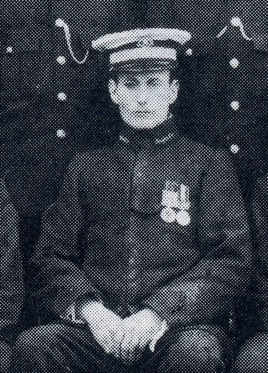Kilmarnock Corporation Tramways
Summary
Kilmarnock Corporation began its tramway operating life in late 1904, though it only lasted some twenty-one and half years, to early summer 1926, a relatively short period, especially when compared to its near neighbour Glasgow Corporation.
Staff were initially issued with uniforms of grey whipcord cloth piped in green. Jackets were single-breasted with five buttons (bearing the full system title and municipal coat of arms — see link), two slit breast pockets and fold-over collars; apart from the buttons, the entire ensemble was devoid of insignia. Caps were in a military style with a soft top, and probably bore standard, 'off-the-shelf' script-lettering grade badges — either Motorman or Conductor — which were presumably brass to match the buttons. These particular uniforms proved to be unsatisfactory (they did not wear well), so were quickly replaced by more robust navy jackets, still single-breasted, but now with button-closure breast pockets and upright collars; the latter bore system initials — 'K C T' — on the bearer's left-hand side (in individual letters), and an employee number on the right-hand side (in individual numerals), all more than likely in brass. The caps also appear to have been changed at the same time to a smarter military style with a tensioned crown (top).
Inspectors wore single-breasted jackets edged in a finer material than the main jacket, and with hidden buttons (or more likely an hook and eye affair), one slit breast pocket and upright collars; the latter bore Inspector in embroidered script lettering on both sides. The cap was in the same style as worn by tramcar crews, and bore a band of a lighter colour, above which was worn a large badge (possibly incorporating a wreath); the latter was more than likely a municipal badge, and would have borne the unofficial arms of Kilmarnock. Kilmarnock also employed the services of a chief inspector, who appears to have been issued with a uniform which was identical to those worn by inspectors, but with Chief Inspector on the collars rather than Inspector.
In common with the vast majority of UK tramway systems, Kilmarnock employed the services of women during the Great War, to replace male staff lost to the armed services, and like many provincial Scottish systems, continued to employ them right through the 1920s. Photographs of female staff are however yet to come to light, so it is currently unclear what uniforms they wore.
For a history of the tramway, see: 'Kilmarnock's Trams and Buses' by A W Brotchie and R L Grieves (N B Traction; 1984).
Images
Motormen and conductors
A newly delivered top-covered tramcar (No 13), in pristine condition, dating the photograph to 1905.
A blow-up of the above photo showing the conductor on the rear platform; his jacket is single-breasted with slit pockets, and appears to be devoid of insignia, though there is a suggestion of a badge on the cap.
The crew of Tramcar No 6 captured for posterity at the Hurlford terminus, probably around 1906/7 (taken from a postcard dated 1908). By this time the earlier uniforms had been replaced by a more robust design.
A blow-up of the above photo showing the motorman, who clearly spent some time on his personal appearance, judging by his impressive moustache.
Another blow-up of the above photo, this time showing the conductor, whose left-hand collar bears the system initials, 'K C T'.
General pattern script-lettering cap badges — Motorman and Conductor — of the type used by Kilmarnock Corporation Tramways.
Depot photo taken in 1906, and featuring: the manager (with dog), the chief inspector, two inspectors, twelve motormen, and seventeen conductors (two part time). Photo reproduced with the kind permission of Brian Deans.
A blow-up of the above photo showing three of the motormen and three of the conductors. The collar insignia are fairly easy to make out.
A conductor and motorman stand with their charge — Tramcar No 12 — at what is possibly the terminus at Beansburn around 1910. Both men have 'K C T' system initials on their left-hand collars, and the standard script-lettering grade badge on their caps.
Senior staff
A blow-up of the staff photo above showing one of the inspectors (or possibly the chief inspector). His cap bears a band of a lighter colour than the rest of the cap, above which is a large badge of unknown pattern, possibly incorporating a wreath. This is the same badge seen on the caps of the two part-time conductors, so was presumably a 'municipal' badge rather than a marked inspector's badge. The subject's medals were presumably for Boer War service.